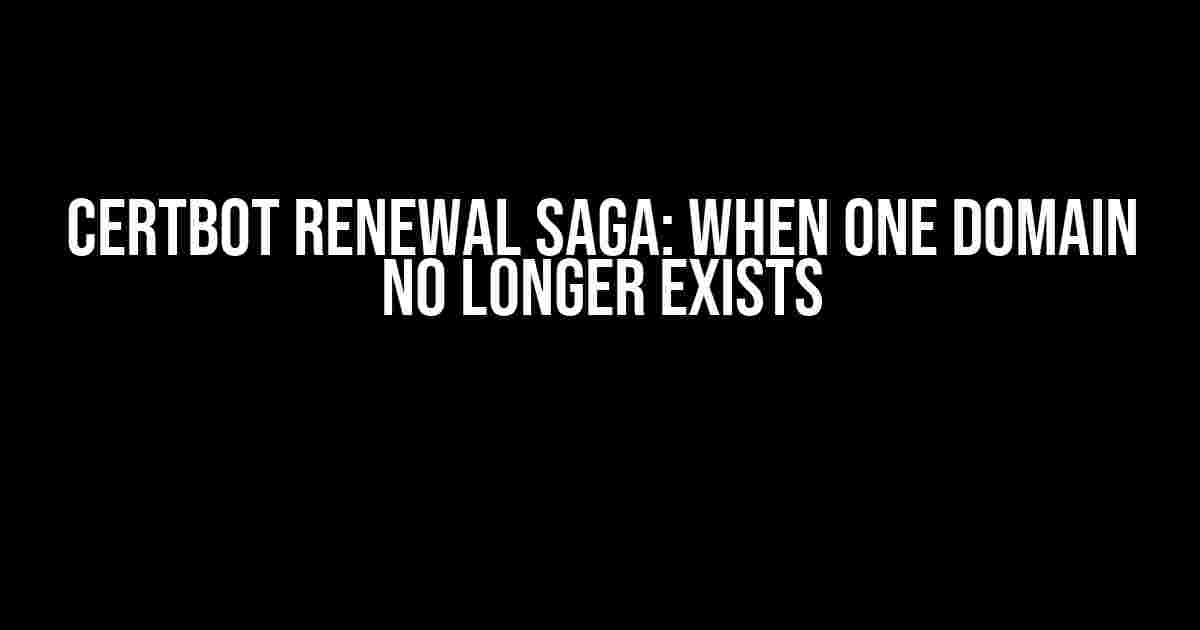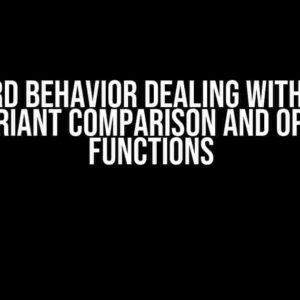If you’re reading this, chances are you’re stuck in the frustrating scenario where Certbot refuses to renew your certificate because one of the domains it covers no longer exists. Don’t worry, friend, we’ve all been there. In this article, we’ll guide you through the process of renewing your certificate while bypassing the pesky domain that’s no longer in the picture.
The Problem: Certbot Errors and Frustration
When you run the command `certbot renew`, you’re met with an error message that looks something like this:
Saving debug log to /var/log/letsencrypt/letsencrypt.log Renewing an existing certificate Performing the following challenges: http-01 challenge for example.com http-01 challenge for olddomain.com http-01 challenge for anothersite.net Waiting for verification... Cleaning up challenges Failed to renew certificate example.com with error: Failed authorization procedure. olddomain.com (http-01): urn:ietf:params:acme:error:unauthorized :: The client lacks sufficient authorization :: Invalid response from http://oldomain.com/.well-known/acme-challenge/[random-string]
The issue is clear: Certbot is trying to renew the certificate, but it can’t reach the non-existent domain `olddomain.com`. This is because Certbot is configured to cover multiple domains, and it’s not smart enough to figure out that one of them doesn’t exist anymore.
Solution 1: Remove the Non-Existent Domain from the Certbot Configuration
The most straightforward solution is to remove the non-existent domain from the Certbot configuration. You can do this by editing the configuration file usually found at `/etc/letsencrypt/renewal/example.com.conf`. Look for the `domains` directive and remove the line containing the old domain:
sudo nano /etc/letsencrypt/renewal/example.com.conf # Remove the line containing the old domain domains = example.com,anothersite.net
Once you’ve made the changes, save and close the file. Then, run `certbot renew` again to see if the certificate renews successfully.
Solution 2: Use the `–domains` Flag
Another approach is to use the `–domains` flag when running `certbot renew`. This allows you to specify which domains you want to include in the certificate renewal process. For example:
sudo certbot renew --domains -d example.com,anothersite.net
This command tells Certbot to only renew the certificate for `example.com` and `anothersite.net`, ignoring the non-existent `olddomain.com`.
Solution 3: Use a Post-Hook to Remove the Non-Existent Domain
If you have a large number of domains and don’t want to manually edit the configuration file or use the `–domains` flag, you can create a post-hook script to remove the non-existent domain. A post-hook is a script that runs after the certificate renewal process.
Create a new file, for example, `remove_old_domain.sh`, with the following contents:
#!/bin/bash sudo sed -i '/olddomain.com/d' /etc/letsencrypt/renewal/example.com.conf
Make the script executable by running `chmod +x remove_old_domain.sh`. Then, add the following line to your `certbot` configuration file (usually `/etc/letsencrypt/cli.ini` or `~/.certbot/cli.ini`):
post-hook = /path/to/remove_old_domain.sh
This will run the script after the certificate renewal process, removing the non-existent domain from the configuration file.
Troubleshooting Common Issues
Here are some common issues you might encounter when trying to renew your certificate with Certbot:
-
Error: “Failed authorization procedure”
This error usually occurs when Certbot can’t reach one of the domains. Check that all domains are correctly configured and reachable.
-
Error: “The client lacks sufficient authorization”
This error means that Certbot doesn’t have the necessary permissions to renew the certificate. Make sure you’re running Certbot with the correct user privileges.
-
Error: “Invalid response from [domain]”
This error occurs when the domain returns a non-200 response code. Check that your web server is correctly configured and that the domain is reachable.
Conclusion
Renewing your certificate with Certbot can be a headache when one of the domains no longer exists. But by using one of the solutions outlined above, you should be able to successfully renew your certificate and avoid the frustration that comes with it. Remember to be patient, and don’t hesitate to seek help if you encounter any issues.
| Solution | Description |
|---|---|
| Remove the non-existent domain from the Certbot configuration | Edit the configuration file to remove the old domain |
| Use the `–domains` flag | Specify which domains to include in the certificate renewal process |
| Use a post-hook to remove the non-existent domain | Create a script to remove the old domain from the configuration file after the certificate renewal process |
By following these instructions, you’ll be able to renew your certificate with Certbot even when one of the domains no longer exists. Happy renewing!
Frequently Asked Question
If you’re struggling to renew a certificate that covers multiple domains, one of which no longer exists, you’re in the right place! Below, we’ve got the answers to your most burning questions.
What happens if I try to renew a certificate that covers multiple domains, one of which no longer exists?
Certbot will throw an error and refuse to renew the certificate if it can’t validate the non-existent domain. This is because Certbot needs to verify that you control all the domains listed on the certificate, and if one of them doesn’t exist, it can’t do that.
Can I just remove the non-existent domain from the certificate?
Yes! You can remove the non-existent domain from the certificate and then renew it. You can do this by updating your Certbot configuration file to exclude the domain, or by using the `–csr` option to specify a new certificate signing request that doesn’t include the non-existent domain.
Will removing the non-existent domain affect the other domains on the certificate?
No, removing the non-existent domain won’t affect the other domains on the certificate. They’ll continue to be covered by the renewed certificate, and you won’t need to take any additional steps to keep them secure.
What if I have multiple certificates that cover multiple domains, and some of those domains no longer exist?
You’ll need to update each certificate individually to remove the non-existent domains. You can use Certbot’s `–expand` option to expand the certificate to include all the remaining domains, and then renew the certificate.
Is there a way to automate the process of removing non-existent domains from certificates?
Yes, you can use Certbot’s `–deploy-hook` option to run a script that automatically removes non-existent domains from your certificate configuration. This way, you can automate the process and save yourself some hassle!




